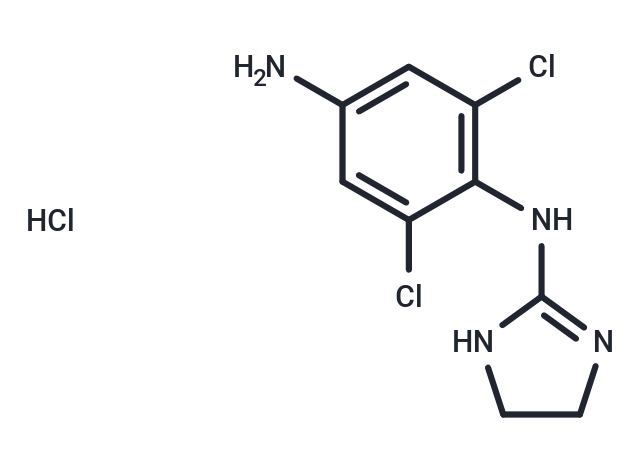Shopping Cart
- Remove All
 Your shopping cart is currently empty
Your shopping cart is currently empty

Apraclonidine hydrochloride (ALO 2145) is an α2-adrenergic agonist and a weak α-1 adrenergic receptor agonist. Apraclonidine hydrochloride lowers intraocular pressure in human eyes and can be used in studies about glaucoma therapy.

| Pack Size | Price | Availability | Quantity |
|---|---|---|---|
| 10 mg | $44 | In Stock | |
| 25 mg | $80 | In Stock | |
| 50 mg | $118 | In Stock | |
| 100 mg | $177 | In Stock | |
| 200 mg | $248 | In Stock | |
| 1 mL x 10 mM (in DMSO) | $30 | In Stock |
| Description | Apraclonidine hydrochloride (ALO 2145) is an α2-adrenergic agonist and a weak α-1 adrenergic receptor agonist. Apraclonidine hydrochloride lowers intraocular pressure in human eyes and can be used in studies about glaucoma therapy. |
| In vitro | Apraclonidine hydrochloride penetrates the cornea and blood-brain barrier to a lesser extent[2]. |
| In vivo | Apraclonidine hydrochloride elevats intraocular pressure as well as glaucoma. Apraclonidine reduces aqueous humor synthesis and vasoconstrictor actions at the anterior segment branches of the ophthalmic artery[2]. Apraclonidine (1.15%) causes a 98% inhibition of PGE2-induced aqueous flare elevationy[3]. |
| Alias | P-aminoclonidine, Iopidine, Apraclonidinum, Apraclonidine HCl, Apraclonidina, ALO 2145, 4-Aminoclonidine |
| Molecular Weight | 281.57 |
| Formula | C9H11Cl3N4 |
| Cas No. | 73218-79-8 |
| Smiles | Cl.Nc1cc(Cl)c(NC2=NCCN2)c(Cl)c1 |
| Relative Density. | 1.63 g/cm3 |
| Storage | Powder: -20°C for 3 years | In solvent: -80°C for 1 year | Shipping with blue ice. | ||||||||||||||||||||||||||||||||||||||||
| Solubility Information | DMSO: 112.5 mg/mL (399.5 mM), Sonication is recommended. H2O: 11.2 mg/mL (39.78 mM), Sonication is recommended. | ||||||||||||||||||||||||||||||||||||||||
Solution Preparation Table | |||||||||||||||||||||||||||||||||||||||||
H2O/DMSO
DMSO
| |||||||||||||||||||||||||||||||||||||||||

Copyright © 2015-2025 TargetMol Chemicals Inc. All Rights Reserved.